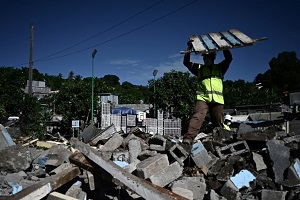Radio Islam and Agencies | 10 Muharram 1438/11 October 2016
Spare a thought for Egyptian men in the firing line from an arsenal of improvised household weapons directed at them by their partners, who have been deemed the world’s top ranked husband abusers.
Statistics released recently by the UN indicate that Egyptian women are ‘world number one’ in abusing and beating their husbands.
Egypt is followed by the United Kingdom and India in the ranking. The data, obtained from the Egyptian Family Court, shows that 66% of wives who abuse and beat their husbands apply for divorce in the Family Court.
Husbands who suffer abuse often have no another way to defend themselves from the violence except by suing their wives, with cases reaching 6000.
The data further reveals that wives don’t only use their hands in beating their husbands, but also tools such as pins, belts, weapons, kitchen tools and shoes. Some even using sleeping pills in order to beat and burn their husbands.
A report from the UK published in 2010 claimed that approximately two in five of all victims of domestic violence in that country were men, contradicting the widespread impression that it is almost always women who are left battered and bruised.
Men assaulted by their partners are often ignored by police, see their attacker go free and have far fewer refuges to flee to than women, said the study by the men’s rights campaign group Parity.
The charity’s analysis of statistics on domestic violence showed the number of men attacked by wives or girlfriends is much higher than thought. Its report, Domestic Violence: The Male Perspective, states: “Domestic violence is often seen as a female victim/male perpetrator problem, but the evidence demonstrates that this is a false picture.”
Campaigners claimed that men are often treated as “second-class victims” and that many police forces and councils do not take them seriously. “Male victims are almost invisible to the authorities such as the police, who rarely can be prevailed upon to take the man’s side,” said John Mays of Parity. “Their plight is largely overlooked by the media, in official reports and in government policy, for example in the provision of refuge places – 7,500 for females in England and Wales but only 60 for men.”
The official figures underestimate the true number of male victims, Mays said. “Culturally it’s difficult for men to bring these incidents to the attention of the authorities. Men are reluctant to say that they’ve been abused by women, because it’s seen as unmanly and weak.”
The number of women prosecuted for domestic violence in the UK rose from 1,575 in 2004-05 to 4,266 in 2008-09. “Both men and women can be victims and we know that men feel under immense pressure to keep up the pretence that everything is OK,” said Alex Neil, then housing and communities minister in the Scottish parliament. “Domestic abuse against a man is just as abhorrent as when a woman is the victim.”
Whilst the statistics are shocking, campaigners say it is still critical to keep in mind that overall, women are still more prone than the male counterparts to experiencing physical violence in different forms; this includes domestic, public, verbal, physical and gender-based sexual violence. In 2013, Amnesty International’s study in Egypt showed 47% of women there had experienced some form of domestic violence.







0 Comments